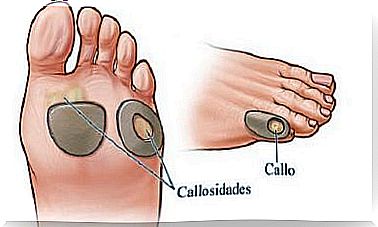Gastroesophageal Reflux Disease: Everything You Need To Know
Gastroesophageal reflux disease is a common pathology identified by the acronym GERD. It is an entity that is influenced by many factors, such as diet, weight and even stress. Due to this type of triggers, its prevalence has increased notably in recent years.
Almost the entire population has experienced acid reflux at some time in their life. However, GERD is not something specific, but goes further. In this article we explain everything you need to know about this entity and how to treat it.
What is gastroesophageal reflux disease?
Gastroesophageal reflux disease consists of the acid content present in the stomach moving up the esophagus frequently. As we noted in the introduction, almost everyone has experienced reflux at some time.
The difference between the disease and specific reflux is that, in this pathology, it happens at least once or twice a week. According to a review article published in the Acta Gastroenterológica Latinoamericana, the prevalence is between 10 and 20% in Western countries. In Asian countries this prevalence is much lower, perhaps due to factors related to their type of diet.
Reflux of acid content occurs because the lower esophageal sphincter is weakened. This sphincter is actually a group of muscles that control the passage of food from the esophagus to the stomach. When this happens and the acid reaches the esophagus repeatedly, the lining of the esophagus is eventually damaged.
In a study published in Anales del Sistema Sanitario de Navarra, they state that one of the most frequent complications is Barret’s esophagus. It is a pathology that produces a series of precancerous changes in the mucosa of the esophagus.
Another possible complication is an esophageal ulcer. Acid can continuously damage the mucosa, causing this lesion to form, which bleeds and complicates digestion.

What are the risk factors for GERD?
As we mentioned at the beginning, this pathology is multifactorial. In other words, its development is influenced by numerous factors. First of all, obesity is one of the most associated, as is diet. People who eat heavily, especially at night, are more likely to suffer from it.
Especially if the meals are high in fat. The same happens among those who abuse alcohol or coffee, since they are substances that increase the secretion of acid in the stomach. Smoking has also been recognized as a risk factor.
According to a study published in Professional Pharmacy, there are other important factors. For example, carbonated drinks, physical exercise and even sleeping in certain positions. Similarly, stress and pregnancy are important triggers for this pathology.
What symptoms does it produce?
The symptoms of gastroesophageal reflux disease can be very upsetting and disabling. Most patients report that they have a burning sensation that works its way up the throat. It usually appears at night or after meals.
This is because, when lying down, it is easier for the stomach contents to back up into the esophagus. Another typical symptom is chest pain, as well as the sensation of having a lump in the throat.
In some people, if the disease progresses, it is common to find difficulty swallowing or breathing. In fact, hoarseness and throat clearing are other common signs in this pathology.
How is gastroesophageal reflux disease diagnosed?
The diagnosis of gastroesophageal reflux disease is complex. First, it is usually based on symptoms. In most cases , a pharmacological treatment is first arranged to check the evolution of the patient.
Even so, after a few weeks, it is recommended to explore the esophagus through complementary tests. It is observed if there is still reflux and if there are injuries or complications derived from it. Below we explain the main tests that are carried out.
Endoscopy in gastroesophageal reflux disease
Endoscopy is a test that involves inserting a thin, flexible tube through a hole in the body. In this case it is done through the throat. This tube has a light and a built-in camera.
Endoscopy allows you to look at the esophagus and check for inflammation or injury. Biopsies of esophageal tissue can even be taken using the same instrument and analyzed later.
Esophageal manometry
Esophageal manometry is a test that measures the pressure and contractions that occur along the esophagus. In this way, the force exerted by the muscles is observed, which may indicate an alteration of the lower esophageal sphincter.
24-hour pH measurement (pHmetry)
To perform this test , a tube is inserted through the nose into the end of the esophagus or into the stomach. With it you can see if reflux episodes occur and how long they last, as it measures changes in pH.
Treatments for gastroesophageal reflux disease
Fortunately, advances in medicine have allowed gastroesophageal reflux disease to be treated in different ways. The first thing is to try to change certain habits and try specific medications that we will talk about in the next section.
In cases where these measures do not work, there are also a series of more aggressive options that can definitively resolve the pathology. First we find the fundoplication.
It is a surgical technique that involves wrapping the upper part of the stomach over the final part of the esophagus. Thus, the sphincter is encompassed and more pressure is exerted, helping the acid content not to rise again.
Another technique is the placement of the LINX device. According to a study published in International ECOS of Surgery, it is a method that has proven to be effective. It is a kind of magnetic ring that selectively closes the junction between the esophagus and the stomach. It prevents reflux, but allows the passage of food.
Treatments and recommendations for the home
Before resorting to surgery, it is important to change certain habits to prevent gastroesophageal reflux disease. First of all, it is essential to reduce body weight. At least in those people in whom obesity is one of the influencing factors.
When eating, the ideal is to remain sitting or standing for about 3 hours to promote the descent of the liquid by gravity. The same can be done if reflux appears overnight. Many people use pillows to elevate the torso. In addition, it is essential to stop smoking.

Over-the-counter medications for gastroesophageal reflux disease
There are medications that are commonly used for gastroesophageal reflux disease that do not need a prescription. For example, antacids like baking soda. However, these types of substances should not be abused, as they do not solve the problem.
The most commonly used drugs are those that block the production of acid in the stomach. First, those that act by inhibiting the proton pump, such as omeprazole. There are also those that act on the histamine receptors in the stomach, although these are usually the second option.
The problem is that these types of drugs, when consumed for a long time, are associated with serious side effects. For example, with an increased risk of cancer, as explained in a study published in the Colombian Journal of Gastroenterology.
Prescription drugs
Some drugs that also act as proton pump inhibitors do require a prescription. For example, esomeprazole or lansoprazole. There are others, such as baclofen, which works by strengthening the lower esophageal sphincter. They are usually more powerful drugs or with a higher risk of side effects.
GERD and changing habits
Gastroesophageal reflux disease is a common pathology influenced by many factors. To prevent it, it is important that we are aware that both obesity and eating habits greatly influence its development.
In addition, it is necessary that before any symptoms you always consult a doctor. Acid can injure the esophagus and lead to serious complications.









